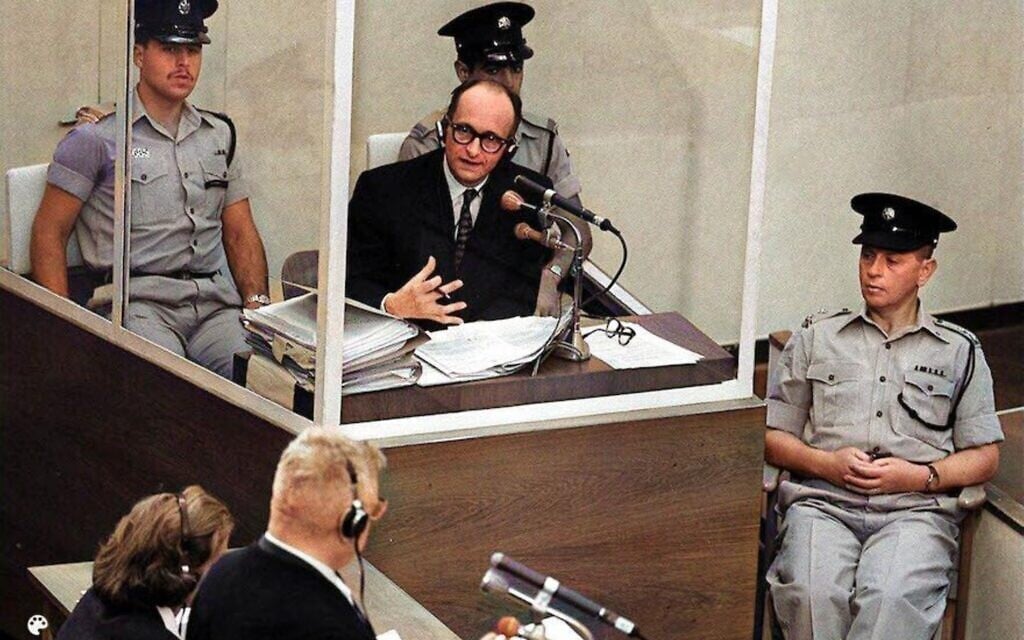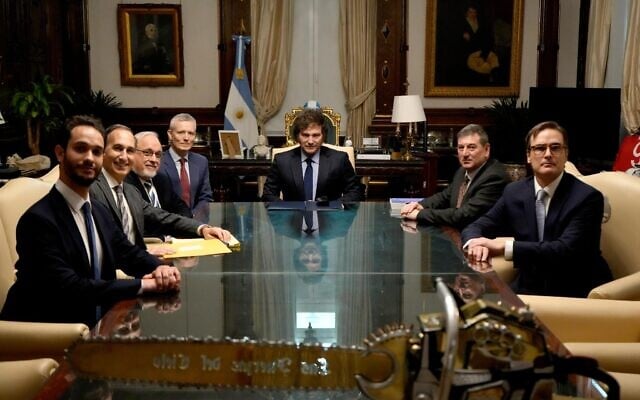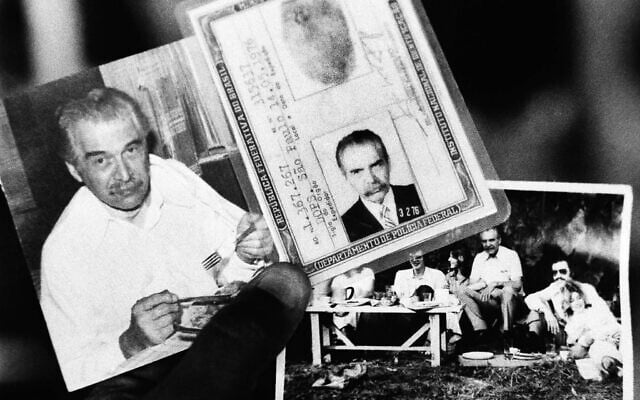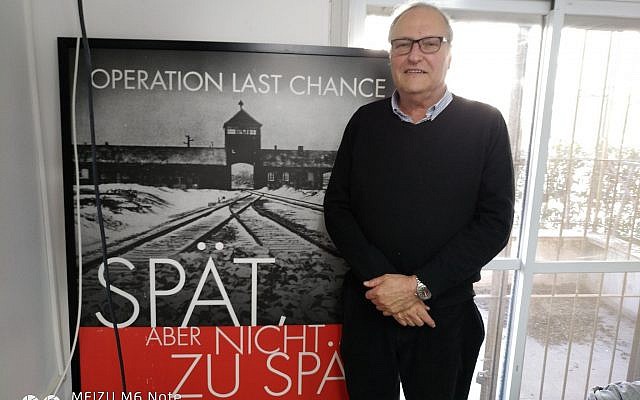 Argentine president opening files on Nazi ‘ratlines’ that trafficked Eichmann, Mengele
Argentine president opening files on Nazi ‘ratlines’ that trafficked Eichmann, Mengele
Matt Lebovic
Up to 10,000 Nazi war criminals fled Europe using these escape routes. Javier Milei pledges to declassify files related to how his country settled 5,000 of them.
 From the trials of Adolf Eichmann, which will be examined in ‘Eichmann — The Devil Speaks,’ the first series produced by Tadmor Entertainment and MGM (Courtesy GPO)
From the trials of Adolf Eichmann, which will be examined in ‘Eichmann — The Devil Speaks,’ the first series produced by Tadmor Entertainment and MGM (Courtesy GPO)
Argentinian President Javier Milei promised officials of the Simon Wiesenthal Center his full cooperation in granting access to documents related to the financing of so-called “ratlines” that helped Nazis escape Europe after the Holocaust. The promise was made in Buenos Aires at the presidential palace, Casa Rosada, during a meeting with Milei and activists on Tuesday.
For decades, organizations including the Simon Wiesenthal Center, named after the famed Nazi hunter, have sought records related to unofficial escape routes taken by thousands of Nazis during the years after World War II. Up to 10,000 Nazis and other fascist war criminals escaped justice by fleeing to Argentina and other countries.
“While some previous leaders promised full cooperation to get to the hard truths that involved Argentina’s past, Milei is the first to act with lightning speed to enable the SWC to uncover important pieces of the historic puzzle, especially as it related to involvement with Nazis before, during and after the Holocaust,” Rabbi Abraham Cooper, associate dean of the Simon Wiesenthal Center, told The Times of Israel.
 Argentine president Javier Milei meets with Simon Wiesenthal Center officials and others in Buenos Aires, Tuesday, February 18, 2025. Jonathan Missner is second from left. Abraham Cooper is third from left. (Courtesy: SWC)
Argentine president Javier Milei meets with Simon Wiesenthal Center officials and others in Buenos Aires, Tuesday, February 18, 2025. Jonathan Missner is second from left. Abraham Cooper is third from left. (Courtesy: SWC)
Nazis’ escape routes
Several countries in the Americas received Nazis, including Canada, the US, and Mexico. Nazis also fled to Australia, Spain, and Switzerland. In some cases, US intelligence officials used ratlines to pluck top Nazi scientists away from Soviet orbits.
One of two primary escape routes went through Germany and Spain, then across the Atlantic to Argentina. The second route went from Germany to Rome, then Genoa, and then across the Atlantic. The elaborate routes developed with unofficial support from several Vatican officials in 1942, initially as an escape path for Catholics fleeing Europe.
“People should understand that for many decades after the Holocaust, governments and multinational corporations helped Nazis hide their stolen money, avoid prosecution, and live the free lives that their victims deserved,” Missner told The Times of Israel.
 A federal police agent holds two photos and the identity card found in the house in which the man believed to be Nazi war criminal Josef Mengele lived, June 7, 1985. Photo on left shows Mengele eating. Photo on right shows Mengele during a picnic with friends and in the middle is the identity card. (AP Photo)
A federal police agent holds two photos and the identity card found in the house in which the man believed to be Nazi war criminal Josef Mengele lived, June 7, 1985. Photo on left shows Mengele eating. Photo on right shows Mengele during a picnic with friends and in the middle is the identity card. (AP Photo)
Up to 5,000 Nazis are said to have settled in Argentina, including Holocaust “architect” Adolf Eichmann and Josef Mengele, one of the most recognizable — and wanted — Nazis. Traveling along a ratline in 1948, the notorious Auschwitz physician used the new identity of Helmut Gregor when fleeing Europe.
“These files will be instrumental in obtaining justice, which is instrumental to honoring the memory of those who suffered and died in the Holocaust,” said Cooper. “Especially in a post-October 7 world, those who financed, facilitated, or otherwise assisted these ratlines must be held accountable,” he said.
‘Will only help historians, if at all’
Not all advocates for Holocaust justice agree that Argentina’s decision was particularly monumental.
“My impression is that the decision to open all the archives regarding the
entry to Argentina of Nazi criminals will only help historians, if at all.
To the best of my knowledge, all the perpetrators are already dead, as well
as the individuals who assisted their escape,” Efraim Zuroff told The Times of Israel.
As a protégé of late Nazi hunter Simon Wiesenthal, Zuroff directed the SWC office in Jerusalem until last year. From Israel, he specialized in bringing eastern European Holocaust perpetrators to justice.
 Nazi hunter Efraim Zuroff in his Jerusalem office, January 2018. (Raphael Ahren/Times of Israel)
Nazi hunter Efraim Zuroff in his Jerusalem office, January 2018. (Raphael Ahren/Times of Israel)
According to Zuroff, author Uki Goni’s “The Real Odessa” book previously “revealed the identity of the criminals, and those who assisted their escape and entry into Argentina,” he said.
But from Missner’s point of view, factors other than securing convictions and revealing names are involved in the matter.
“Words are one thing — actions are another. President Milei’s historic decision signals his unequivocal allyship with the Jewish community while reinforcing his commitment to accountability and transparency at home,” Missner told The Times of Israel.
Support for harboring Nazi war criminals went right to the top in Argentina, according to historians. President Juan Peron was angered by the Nuremberg Trials and authorized key facets of the escape routes, making them a state affair. In addition to German Nazis, the Peron regime and other South American governments aided war criminals from Hungary, Croatia and elsewhere.
“President Milei is a staunch ally of the global Jewish community and was eager to open these archives. He knows that confronting Argentina’s history of Nazi collaboration requires nothing less than full transparency, and the same principle undergirds his pursuit of justice for the AMIA bombing,” said Missner.
Zawartość publikowanych artykułów i materiałów nie reprezentuje poglądów ani opinii Reunion’68,
ani też webmastera Blogu Reunion’68, chyba ze jest to wyraźnie zaznaczone.
Twoje uwagi, linki, własne artykuły lub wiadomości prześlij na adres:
webmaster@reunion68.com
